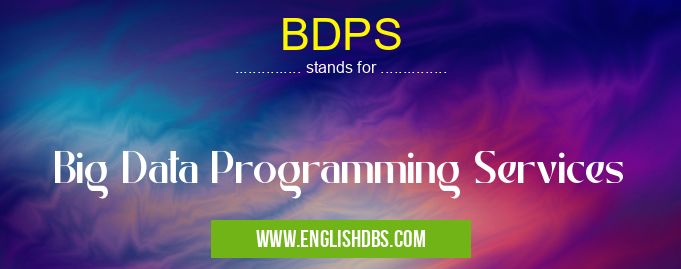What does BDPS mean in GENERAL
BDPS stands for Big Data Programming Services. It refers to specialized services that provide programming expertise and support for managing and analyzing large and complex datasets. BDPS helps organizations leverage the vast amount of data generated today to gain valuable insights and make informed decisions.

BDPS meaning in General in Computing
BDPS mostly used in an acronym General in Category Computing that means Big Data Programming Services
Shorthand: BDPS,
Full Form: Big Data Programming Services
For more information of "Big Data Programming Services", see the section below.
What Does BDPS Stand For?
BDPS is an abbreviation for Big Data Programming Services. It encompasses various programming languages, frameworks, and tools designed to handle large-scale data processing, data analysis, and data visualization tasks. BDPS enables organizations to efficiently manage and extract meaningful insights from their data.
Use Cases of BDPS
BDPS finds applications in numerous industries and sectors, including:
- Healthcare: Analyzing medical data to identify patterns, predict disease risks, and personalize treatments.
- Finance: Processing financial transactions, detecting fraud, and optimizing investment strategies.
- Retail: Analyzing customer behavior, personalizing recommendations, and improving supply chain management.
- Manufacturing: Monitoring production lines, optimizing processes, and predicting maintenance needs.
- Government: Analyzing social trends, improving public services, and enhancing national security.
Benefits of BDPS
Utilizing BDPS offers several benefits:
- Improved Data Management: Efficiently handle large and complex datasets, ensuring data integrity and accessibility.
- Enhanced Data Analysis: Perform in-depth data analysis to uncover hidden patterns, trends, and correlations.
- Accurate Forecasting: Utilize predictive analytics to anticipate future events and make data-driven decisions.
- Real-Time Insights: Process and analyze data in real-time to respond quickly to changing business conditions.
- Competitive Advantage: Gain valuable insights from data to stay ahead of competitors and adapt to market dynamics.
Essential Questions and Answers on Big Data Programming Services in "COMPUTING»GENERALCOMP"
What are Big Data Programming Services (BDPS)?
BDPS are specialized services that provide organizations with the expertise and tools necessary to manage and process large volumes of data efficiently. These services assist in extracting insights, identifying patterns, and making data-driven decisions.
What are the benefits of using BDPS?
BDPS offer numerous benefits, including improved operational efficiency, enhanced decision-making, increased revenue opportunities, reduced costs, and improved customer experience.
What types of data can BDPS handle?
BDPS are designed to handle a wide range of data types, including structured data (e.g., relational databases), unstructured data (e.g., text, images, videos), and semi-structured data (e.g., XML, JSON).
How do BDPS ensure data security?
BDPS prioritize data security by implementing robust encryption algorithms, access controls, and compliance with industry-standard regulations such as GDPR and HIPAA.
What are the different types of BDPS?
BDPS vary based on the specific needs of organizations. Some common types include data analytics, data engineering, data visualization, and data management.
How do I choose the right BDPS provider?
When selecting a BDPS provider, consider factors such as expertise, experience, technology used, support, and cost. It's essential to choose a provider that aligns with your organization's goals and requirements.
What are the trends in BDPS?
BDPS are continuously evolving to meet the changing demands of data management. Trends include the adoption of artificial intelligence (AI) and machine learning (ML), cloud-based solutions, and increased focus on real-time data analysis.
Final Words: BDPS empowers organizations to harness the power of big data by providing specialized programming services. It facilitates efficient data management, in-depth analysis, and accurate forecasting, enabling organizations to make informed decisions, optimize operations, and gain a competitive edge in the data-driven era.
